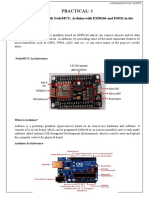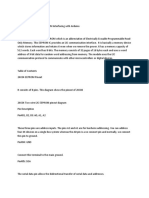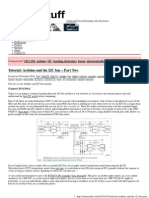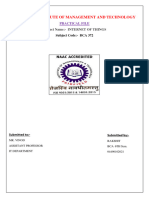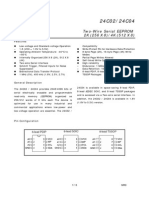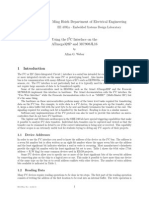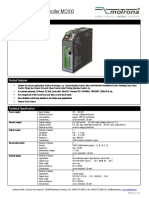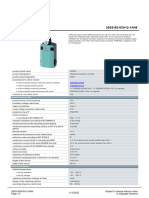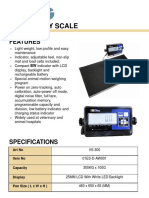Eepro
Eepro
Uploaded by
Ankit DhimanCopyright:
Available Formats
Eepro
Eepro
Uploaded by
Ankit DhimanOriginal Description:
Original Title
Copyright
Available Formats
Share this document
Did you find this document useful?
Is this content inappropriate?
Copyright:
Available Formats
Eepro
Eepro
Uploaded by
Ankit DhimanCopyright:
Available Formats
Electronics Note: Interfacing PIC Microcontroller With External EEPROM http://elecnote.blogspot.in/2015/03/interfacing-pic-microcontroller-with.
html
1 of 4
More
Next Blog
ankitdhimancr@gmail.com
Dashboard
Sign Out
This blog provides electronic circuits specially based on PIC microcontrollers and Arduino boards
Home
Arduino Projects
PIC18F4550 Projects
PIC16F877A Projects
PIC16F84A Projects
More
Programmers
About Blog
Search :
Friday, March 27, 2015
Interfacing PIC Microcontroller With External EEPROM
Translate
Select Language
Translate
Powered by
TOPICS:
7 Segment (4)
Arduino (15)
Interfacing PIC16F877A with 24C08A EEPROM
The EEPROM is used in most of the electronic equipments like televisions, computers, digital
clocks ....It is used to store data.
The 24C eeprom series is one of the mostly used today, this type of memory uses the I2C
protocol to communicate with the master device.
The 24C08A eeprom has 8 Kbit of memory (1KByte) its pin assignment as shown below:
DC Motors (9)
LCD (15)
LED (13)
Microcontroller (24)
MikroC (2)
PIC16F84A (11)
PIC16F877A (23)
PIC16F887 (2)
PIC18F4550 (5)
Programmer (3)
Real Time Clock (7)
Remote Control (8)
A0, A1, A2: used for device addressing according to the following table:
Schematic (6)
Sensor (7)
Software (1)
Useful Web Links
http://www.arduino.cc/
http://www.mikroe.com/
About Me
Popular Posts:
PIC16F877A Projects
PIC16F877A Projects
PIC16F877A Projects
with MikroC Codes List
of microchip
PIC16F877A Projects
done on this blog:
Interfa...
Cd-Rom Brushless DC
Motor Control
Sensored BLDC Motor
Control Using
PIC16F877A Sensored
BLDC Motor Control
This topic shows how
to control sensored
brushless dc motor....
EEPROM (1)
Proteus (5)
Archive:
Cd-Rom 3 phase
Sensored BLDC Motor
Arduino Controller
Sensored BLDC Motor
Control BLDC
(brushless dc) motors
are three phase dc
motors, unlike the
simple dc motors the
bldc motors are more
...
For example in general when A0, A1, A2 connected to ground the device address becomes:
(for 24C08A A0 & A1 can be disconnected).
Write data to EEPROM:
Start I2C protocol,
Send EEPROM write mode address,
Send byte address,
Send data,
Stop the I2C protocol.
The 24C08A has 1024 bytes of memory organized as 4 blocks of 256 bytes.
Assume A2 connected to ground, the addressing of our eeprom bcomes as shown on the
following table:
Electron Note
205
View my complete profile
P1 and P0 are called the page address which used to to select one of the four pages of 24C08A
EEPROM.
So, the complete process of writing byte is shown below:
MikroC PRO For PIC code:
(0xA0 means that we are at page0)
11/5/2015 6:57 PM
Electronics Note: Interfacing PIC Microcontroller With External EEPROM http://elecnote.blogspot.in/2015/03/interfacing-pic-microcontroller-with.html
2 of 4
void write_data(char
I2C1_Start();
I2C1_Wr(0xA0);
I2C1_Wr(address);
I2C1_Wr(data_);
I2C1_Stop();
}
address, char data_){
// start I2C signal
// Send EEPROM and page address
// Send byte address
// Write data
// Stop I2C protocol
Read data from EEPROM:
Start I2C protocol,
Send EEPROM write mode address,
Send byte address,
I2C repeated start,
Send EEPROM read mode address,
Read data from EEPROM,
Stop the I2C protocol.
MikroC PRO For PIC code:
void read_data(char address){
I2C1_Start();
// start I2C signal
I2C1_Wr(0xA0);
// Send EEPROM and page address at write mode
I2C1_Wr(address);
// Send byte address
I2C1_Repeated_Start();
I2C1_Wr(0xA1);
// Send EEPROM and page address at read mode
a = I2C1_Rd(0);
I2C1_Stop();
// Stop I2C protocol
}
Example:
Interfacing PIC16F877A with 24C08A EEPROM
Circuit schematic:
On this application I am going to write 4 different values at different addresses then read these
values and display it on 1602 LCD display.
The values are: (decimal)
7 at address 10, 141 at address 320, 255 at address 680 and 224 at address 1010.
The LCD displays as shown on the previous picture.
MiKroC code:
// LCD module connections
sbit LCD_RS at RB0_bit;
sbit LCD_EN at RB1_bit;
sbit LCD_D4 at RB2_bit;
sbit LCD_D5 at RB3_bit;
sbit LCD_D6 at RB4_bit;
sbit LCD_D7 at RB5_bit;
sbit LCD_RS_Direction at TRISB0_bit;
sbit LCD_EN_Direction at TRISB1_bit;
sbit LCD_D4_Direction at TRISB2_bit;
sbit LCD_D5_Direction at TRISB3_bit;
sbit LCD_D6_Direction at TRISB4_bit;
sbit LCD_D7_Direction at TRISB5_bit;
// End LCD module connections
char a ;
void write_data(unsigned address, char data_){
11/5/2015 6:57 PM
Electronics Note: Interfacing PIC Microcontroller With External EEPROM http://elecnote.blogspot.in/2015/03/interfacing-pic-microcontroller-with.html
3 of 4
char device_address;
device_address = 0xA0;
if(address > 767) {address -= 768;
device_address = 0xA6;
goto write;}
if(address > 511) {address -= 512;
device_address = 0xA4;
goto write;}
if(address > 255) {address -= 256;
device_address = 0xA2;
goto write;}
write:
I2C1_Start();
I2C1_Wr(device_address);
I2C1_Wr(address);
I2C1_Wr(data_);
I2C1_Stop();
}
void read_data(unsigned address){
char device_address;
device_address = 0xA0;
if(address > 767) {address -= 768;
device_address = 0xA6;
goto read;}
if(address > 511) {address -= 512;
device_address = 0xA4;
goto read;}
if(address > 255) {address -= 256;
device_address = 0xA2;
goto read;}
read:
I2C1_Start();
// start I2C signal
I2C1_Wr(device_address);
I2C1_Wr(address);
I2C1_Repeated_Start();
I2C1_Wr(device_address + 1);
a = I2C1_Rd(0);
I2C1_Stop();
}
void main(){
Lcd_Init();
Lcd_Cmd(_LCD_CURSOR_OFF);
// cursor off
Lcd_Cmd(_LCD_CLEAR);
// clear LCD
I2C1_Init(100000); // initialize I2C protocol at 100KHz
delay_ms(20);
write_data(10, 0x07);
delay_ms(20);
write_data(320, 0x8D);
delay_ms(20);
write_data(680, 0xFF);
delay_ms(20);
write_data(1010, 0xE0);
delay_ms(20);
read_data(10);
Lcd_Chr(1, 2, (a/100) + 48);
Lcd_Chr(1, 3, ((a/10)%10) + 48);
Lcd_Chr(1, 4, (a % 10) + 48);
read_data(320);
Lcd_Chr(1, 8, (a/100) + 48);
Lcd_Chr(1, 9, ((a/10)%10) + 48);
Lcd_Chr(1, 10, (a % 10) + 48);
read_data(680);
Lcd_Chr(2, 2, (a/100) + 48);
Lcd_Chr(2, 3, ((a/10)%10) + 48);
Lcd_Chr(2, 4, (a % 10) + 48);
read_data(1010);
Lcd_Chr(2, 8, (a/100) + 48);
Lcd_Chr(2, 9, ((a/10)%10) + 48);
Lcd_Chr(2, 10, (a % 10) + 48);
}
while(1);
// Endless loop
at Friday, March 27, 2015
Labels: EEPROM, PIC16F877A
+9 Recommend this on Google
11/5/2015 6:57 PM
Electronics Note: Interfacing PIC Microcontroller With External EEPROM http://elecnote.blogspot.in/2015/03/interfacing-pic-microcontroller-with.html
4 of 4
3 comments
Add a comment as Ankit Dhiman
Top comments
Electron Note shared this via Google+ 7 months ago - Shared publicly
+2
3
Reply
Electron Note via Google+ 7 months ago - Shared publicly
Interfacing PIC Microcontroller With External EEPROM
Interfacing PIC16F877A with 24C08A EEPROM The EEPROM is used in
most of the electronic equipments like televisions, computers, digital
clocks ....It is used to store data. The 24C eeprom series is one of the
mostly used today, this type of memory uses the ...
+3
4
Reply
Electron Note shared this via Google+ 4 months ago - Shared publicly
+2
3
Reply
Newer Post
Home
Older Post
Subscribe to: Post Comments (Atom)
11/5/2015 6:57 PM
You might also like
- Fujitsu Air Conditioner Service ManualDocument22 pagesFujitsu Air Conditioner Service Manualnovy100% (1)
- ESP32 Development Using The Arduino IDEDocument162 pagesESP32 Development Using The Arduino IDEGOMEZ100% (5)
- Bose Sound SystemDocument12 pagesBose Sound Systemboileroood2100% (1)
- Practical: 1: Aim: Getting Started With Nodemcu, Arduino With Esp8266 and Esp32 in The Arduino IdeDocument25 pagesPractical: 1: Aim: Getting Started With Nodemcu, Arduino With Esp8266 and Esp32 in The Arduino IdeGanesh GhutiyaNo ratings yet
- How To Interface I2C-EEPROM With LPC2148 - ARM7 SlickerDocument8 pagesHow To Interface I2C-EEPROM With LPC2148 - ARM7 SlickerabidparwezNo ratings yet
- How To Write An Industry-Standard EEPROM (24C04) Using The MAX2990 I C InterfaceDocument4 pagesHow To Write An Industry-Standard EEPROM (24C04) Using The MAX2990 I C InterfaceOrcasNo ratings yet
- A6b 8051 Interfacing EEPROM AT24C16Document3 pagesA6b 8051 Interfacing EEPROM AT24C16Phan HiếuNo ratings yet
- Ds1307 InterfacingDocument8 pagesDs1307 InterfacinggudduNo ratings yet
- 24AA254 Memory I2C With The XC8 C Compiler - AN1488ADocument24 pages24AA254 Memory I2C With The XC8 C Compiler - AN1488Aalexandre.oneill2479No ratings yet
- STM32 Tutorial 04 - I2C Module (Pca9685) Using HAL (And FreeRTOS)Document6 pagesSTM32 Tutorial 04 - I2C Module (Pca9685) Using HAL (And FreeRTOS)Quocdt Ngoc100% (1)
- Transforming Your AVR Microcontroller To The I2C or TWI Slave I - O Expander Project - ErmicroblogDocument18 pagesTransforming Your AVR Microcontroller To The I2C or TWI Slave I - O Expander Project - Ermicroblogمحمد الد ين الفجرNo ratings yet
- Embedded Sysytem FileDocument52 pagesEmbedded Sysytem FileGagan MaggoNo ratings yet
- 1 2 3 MergedDocument38 pages1 2 3 MergedthesoulmatecreationNo ratings yet
- I 2 CDocument48 pagesI 2 CMohit DayalNo ratings yet
- Hands-On I2C Arduino - Practical GuidedDocument6 pagesHands-On I2C Arduino - Practical Guidedecouwoo@scribdNo ratings yet
- Ethernet Chat Client Tutorial: What You NeedDocument7 pagesEthernet Chat Client Tutorial: What You NeedHiddendarkness Iced SunNo ratings yet
- IOT1Document23 pagesIOT1thesoulmatecreationNo ratings yet
- Inter-Integrated Circuit (I2C) : Karthik Hemmanur ECE 480-Design Team 3 Fall 2009Document8 pagesInter-Integrated Circuit (I2C) : Karthik Hemmanur ECE 480-Design Team 3 Fall 2009gluciferNo ratings yet
- Testing Pic Code For I2C Master - Slave CommunicationDocument15 pagesTesting Pic Code For I2C Master - Slave CommunicationJavier Corimaya33% (3)
- 9 I2c-SpiDocument40 pages9 I2c-SpiTam PhamNo ratings yet
- Speaker 8 OhmDocument6 pagesSpeaker 8 OhmMuhammad HassanNo ratings yet
- Firmata WIFIDocument37 pagesFirmata WIFIsoo chiNo ratings yet
- 24 C 04Document13 pages24 C 04Yasser Ya100% (1)
- I2C Interface TutorialDocument6 pagesI2C Interface Tutorialtomas duranNo ratings yet
- Part 1Document30 pagesPart 1ady63100% (1)
- EEPROM Module User Manual PDFDocument5 pagesEEPROM Module User Manual PDFIhsan Baalbaki100% (1)
- I2c EEPROM FULL CODEDocument24 pagesI2c EEPROM FULL CODESumathi AnandNo ratings yet
- How To Use ESP8266 With PCF8574 - 4 Input and 4 Output: Step 1: ComponentsDocument5 pagesHow To Use ESP8266 With PCF8574 - 4 Input and 4 Output: Step 1: ComponentsedermadrugaNo ratings yet
- I2C Use On The STM32F103R Medium Density Devices - Micromouse Online PDFDocument12 pagesI2C Use On The STM32F103R Medium Density Devices - Micromouse Online PDFNguyễn Văn ThắngNo ratings yet
- Instant download (Ebook) ESP32 Programming for the Internet of Things by SEVER SPÂNULESCU pdf all chapterDocument59 pagesInstant download (Ebook) ESP32 Programming for the Internet of Things by SEVER SPÂNULESCU pdf all chapteredellbaconp7100% (7)
- Standard Firmata EthernetDocument34 pagesStandard Firmata Ethernetsoo chiNo ratings yet
- Using Serial Peripheral InterfaceDocument21 pagesUsing Serial Peripheral InterfaceArton TonoNo ratings yet
- Build A Simple PLC Using ArduinoDocument7 pagesBuild A Simple PLC Using ArduinoFredy Peñafiel Paz100% (2)
- 66d4523741098e13a4c290f7 WiFi Module ESP8266Document5 pages66d4523741098e13a4c290f7 WiFi Module ESP8266KhOa LêNo ratings yet
- Clock With Thermometer Using Arduino, I2c 16x2 Lcd, DS1307 RTC and DHT11 Sensor. - InstructablesDocument4 pagesClock With Thermometer Using Arduino, I2c 16x2 Lcd, DS1307 RTC and DHT11 Sensor. - InstructablesmelchizedekcheNo ratings yet
- Interfacing With The ISA BusDocument12 pagesInterfacing With The ISA BusseyfiNo ratings yet
- W5500 UDP Problem - Open Hardware - W5500 Ethernet Shield - WIZnet Developer ForumDocument8 pagesW5500 UDP Problem - Open Hardware - W5500 Ethernet Shield - WIZnet Developer Forumbokic88No ratings yet
- Tutorial - Arduino and The I2C Bus - Part TwoDocument16 pagesTutorial - Arduino and The I2C Bus - Part TwoSigid Ariewibowo100% (1)
- Check The EEPROM Chip On Your ScreenDocument6 pagesCheck The EEPROM Chip On Your ScreencemisyxNo ratings yet
- IOT Practical File BCADocument20 pagesIOT Practical File BCAinfinitybros2003No ratings yet
- PIC - New - Part 1 PIC Microcontroller Systems PDFDocument5 pagesPIC - New - Part 1 PIC Microcontroller Systems PDFLam Nguyen100% (1)
- 24C 04Document15 pages24C 04Diego AsiconaNo ratings yet
- Principle of I2C Bus and Its Application in IC Design: Li Yifan, Mo FeiDocument9 pagesPrinciple of I2C Bus and Its Application in IC Design: Li Yifan, Mo FeiPronadeep BoraNo ratings yet
- code 2Document6 pagescode 2h210595vNo ratings yet
- PCF8591 1Document7 pagesPCF8591 1Ashesh PradhanNo ratings yet
- MES MODULE 5 Programming Using ArduinoDocument41 pagesMES MODULE 5 Programming Using Arduinodaniel007workNo ratings yet
- Web Server PDFDocument7 pagesWeb Server PDFArdian Ramadita SugaraNo ratings yet
- Protocolo I2CDocument12 pagesProtocolo I2Cディエゴ水上100% (2)
- programming Avr I2c InterfaceDocument11 pagesprogramming Avr I2c Interfacezbhp zNo ratings yet
- InOutPelan Induk Perindustrian (PIP) 1986 Pengenalan Sejak mencapai kemerdekaan, kerajaan Malaysia telah menggiatkan usaha kearah mewujudkan Malaysia sebagai sebuah Negara perindustrian. Usaha ini merupakan satu langkah baharu kerajaan untuk mempelbagaikan sektor ekonomi Negara supaya tidak hanya bergantung kepada getah dan bijih timah sahaja. • Usaha kerajaan bukan sahaja untuk memajukan Negara dengan cara mempelbagaikan kegiatan perindustrian, tetapi juga untuk menyediakan peluang pekerjaan yang lebih banyak kepada rakyat. Selain menyediakan peluang pekerjaan, sektor ini juga akan dapat menjadi pengeksport utama Negara dan menyediakan latihan teknikal serta kemahiran kepada rakyat tempatan. • Memandangkan dasar kerajaan untuk menjadikan sektor perindustriam sebagai industi utama Negara dalam jangka masa panjang, pihak kerajaan telah menubuhkan satu jawatankuasa kajian Dasar Perindustrian Negara dan Pelan Induk Perindustrian (PIP) pada 3 Febuari 1986 untuk menyemakDocument42 pagesInOutPelan Induk Perindustrian (PIP) 1986 Pengenalan Sejak mencapai kemerdekaan, kerajaan Malaysia telah menggiatkan usaha kearah mewujudkan Malaysia sebagai sebuah Negara perindustrian. Usaha ini merupakan satu langkah baharu kerajaan untuk mempelbagaikan sektor ekonomi Negara supaya tidak hanya bergantung kepada getah dan bijih timah sahaja. • Usaha kerajaan bukan sahaja untuk memajukan Negara dengan cara mempelbagaikan kegiatan perindustrian, tetapi juga untuk menyediakan peluang pekerjaan yang lebih banyak kepada rakyat. Selain menyediakan peluang pekerjaan, sektor ini juga akan dapat menjadi pengeksport utama Negara dan menyediakan latihan teknikal serta kemahiran kepada rakyat tempatan. • Memandangkan dasar kerajaan untuk menjadikan sektor perindustriam sebagai industi utama Negara dalam jangka masa panjang, pihak kerajaan telah menubuhkan satu jawatankuasa kajian Dasar Perindustrian Negara dan Pelan Induk Perindustrian (PIP) pada 3 Febuari 1986 untuk menyemakPak TamNo ratings yet
- Manual Xec3 enDocument22 pagesManual Xec3 enLuis NascimentoNo ratings yet
- C TutorialDocument26 pagesC TutorialRebecca SouzaNo ratings yet
- Using TC74 Temp SensorDocument13 pagesUsing TC74 Temp SensorGaneshVenkatachalamNo ratings yet
- OneWire Ds18b020 Termometre UygulamasımikrocDocument4 pagesOneWire Ds18b020 Termometre Uygulamasımikrocabdulkadir dönerNo ratings yet
- iot labDocument48 pagesiot labSņap SĘlvaNo ratings yet
- IOT PracticalDocument10 pagesIOT PracticalParmar Manthan100% (1)
- Microcontroller Architecture PIC18F Family: Microcontrollers Digital Systems Iii Dr. Remberto Sandoval ArechigaDocument29 pagesMicrocontroller Architecture PIC18F Family: Microcontrollers Digital Systems Iii Dr. Remberto Sandoval ArechigaAngel CallejebrioNo ratings yet
- 8086 UsermanualDocument62 pages8086 Usermanual肯恩No ratings yet
- C Programming for the Pc the Mac and the Arduino Microcontroller SystemFrom EverandC Programming for the Pc the Mac and the Arduino Microcontroller SystemNo ratings yet
- Xmcf01 Ds Gfa XXXXDocument2 pagesXmcf01 Ds Gfa XXXXAnkit DhimanNo ratings yet
- Acti 9 A9Q11225Document2 pagesActi 9 A9Q11225Ankit DhimanNo ratings yet
- DRDO RAC Recruitment Advt.Document4 pagesDRDO RAC Recruitment Advt.Soni Mishra TiwariNo ratings yet
- Programming in C TutorialDocument9 pagesProgramming in C TutorialAnkit DhimanNo ratings yet
- Advances in Electronics & Communication Technologies (NCAECT-2015)Document2 pagesAdvances in Electronics & Communication Technologies (NCAECT-2015)Ankit DhimanNo ratings yet
- Decimals Multi Divi 2Document2 pagesDecimals Multi Divi 2Ankit DhimanNo ratings yet
- Programmer For 89C51 - 52 - 55 89S51 - 52Document6 pagesProgrammer For 89C51 - 52 - 55 89S51 - 52Ankit DhimanNo ratings yet
- Registration Form LatestDocument1 pageRegistration Form LatestAnkit DhimanNo ratings yet
- Ai-518 V7.5Document16 pagesAi-518 V7.5Ankit DhimanNo ratings yet
- Https WWW - Irctc.co - in Eticketing PrintTicketDocument1 pageHttps WWW - Irctc.co - in Eticketing PrintTicketAnkit DhimanNo ratings yet
- AI-518/AI-518P Artificial Intelligence Industrial ControllerDocument58 pagesAI-518/AI-518P Artificial Intelligence Industrial ControllerAnkit DhimanNo ratings yet
- Bead Dealers in Chawri Bazar, Delhi, India - JustdialDocument6 pagesBead Dealers in Chawri Bazar, Delhi, India - JustdialAnkit DhimanNo ratings yet
- FIITJEE Solutions To NTSE STAGE-I (2014) (For Class X Students) (MAT)Document8 pagesFIITJEE Solutions To NTSE STAGE-I (2014) (For Class X Students) (MAT)Ankit Dhiman100% (1)
- Decimals Division 4Document2 pagesDecimals Division 4Ankit DhimanNo ratings yet
- Decimals Division 2Document2 pagesDecimals Division 2Ankit DhimanNo ratings yet
- One-Step Equations - Addition and SubtractionDocument2 pagesOne-Step Equations - Addition and SubtractionAnkit DhimanNo ratings yet
- Decimals Division 3Document2 pagesDecimals Division 3Ankit DhimanNo ratings yet
- Decimals Division 1Document2 pagesDecimals Division 1Ankit DhimanNo ratings yet
- 028-Fuel Filter PDFDocument3 pages028-Fuel Filter PDFبهية عمرNo ratings yet
- Instructor CD Comercial Refrigeration For A:C Technicians Chapter 2 EvaporationsDocument58 pagesInstructor CD Comercial Refrigeration For A:C Technicians Chapter 2 EvaporationsDJ GNo ratings yet
- Compal La 6552p r1 Schematics PDFDocument46 pagesCompal La 6552p r1 Schematics PDFMihael PolakNo ratings yet
- Mc800 Universal Motion Controller DSDocument2 pagesMc800 Universal Motion Controller DSendangfarid hidayatNo ratings yet
- 3SE51620CH121AN5 Datasheet enDocument4 pages3SE51620CH121AN5 Datasheet enrayggzz_88482611No ratings yet
- 3584, BC Nr1212 Rev04 Stx-Sqx-ManualDocument23 pages3584, BC Nr1212 Rev04 Stx-Sqx-ManualIhabNo ratings yet
- Javelin Bwml2B (X) Black & White Monitor: Instruction ManualDocument7 pagesJavelin Bwml2B (X) Black & White Monitor: Instruction ManualAronNo ratings yet
- Chapter Os DSTV 4-1Document6 pagesChapter Os DSTV 4-1yaikobdiriba1No ratings yet
- Catalogue Battery Chargers-A4 PDFDocument8 pagesCatalogue Battery Chargers-A4 PDFdinhvuNo ratings yet
- Three Phase Power MeasurementDocument9 pagesThree Phase Power MeasurementMohamed AbohassanNo ratings yet
- Cyclone IV Product TableDocument1 pageCyclone IV Product Table15767340887No ratings yet
- VS 300Document1 pageVS 300Eong Huat Corporation Sdn BhdNo ratings yet
- Bol N A PDFDocument1 pageBol N A PDFAndres LopezNo ratings yet
- Masterflow P1E ChokeDocument3 pagesMasterflow P1E ChokeM CramerNo ratings yet
- Home Appliance Control by Mobile Phone DTMF Ieee Ece Final Year ProjectDocument15 pagesHome Appliance Control by Mobile Phone DTMF Ieee Ece Final Year ProjectRajan SoniNo ratings yet
- Power Transmission IOEDocument94 pagesPower Transmission IOEEr. Satya Narayan Shah100% (2)
- JOSOP 450 - High Voltage Electrical SafetyDocument18 pagesJOSOP 450 - High Voltage Electrical SafetyDhimaz YudiNo ratings yet
- Q1 Lesson 1 - Introduction To Computer & Its CharacteristicsDocument23 pagesQ1 Lesson 1 - Introduction To Computer & Its CharacteristicsAlyssaNo ratings yet
- Electrical Estimate Template PDFDocument1 pageElectrical Estimate Template PDFMEGAWATT CONTRACTING AND ELECTRICITY COMPANYNo ratings yet
- Manual MIVII Voltage-Frequency RelayDocument231 pagesManual MIVII Voltage-Frequency RelayKiko OliveiraNo ratings yet
- Color Monitor: Service ManualDocument44 pagesColor Monitor: Service ManualPaulo Roberto s freireNo ratings yet
- TriPyramid Rods&CablesDocument1 pageTriPyramid Rods&CablesMikeNo ratings yet
- WABCODocument106 pagesWABCOMohan Raj VeerasamiNo ratings yet
- Hanbell-RC Technical ManualDocument75 pagesHanbell-RC Technical ManualMyo SeinNo ratings yet
- Water Pump Fitting Instructions: Monteringsvejledning VandpumpeDocument2 pagesWater Pump Fitting Instructions: Monteringsvejledning VandpumpehermanNo ratings yet
- UFD11A-00 DeviceNet SewDocument44 pagesUFD11A-00 DeviceNet Sewoat oatNo ratings yet
- Tle Eim9 - q3 - Mod1 - Install - Wire - Ways - and - Cable - Trays - v3Document18 pagesTle Eim9 - q3 - Mod1 - Install - Wire - Ways - and - Cable - Trays - v3Norman PolilinNo ratings yet



